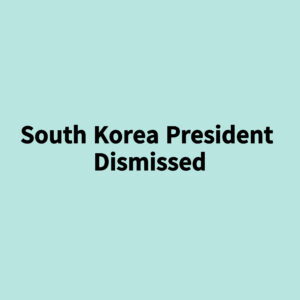South Korea President Yoon Suk-yeol Removed from Office: A Timeline of Events
South Korea has entered a period of political turmoil following the removal of President Yoon Suk-yeol from office. His impeachment and subsequent dismissal have captured international attention, raising concerns about the country’s democratic stability.
This article outlines the key events leading up to his removal, starting from his controversial declaration of martial law in December 2024 to the Constitutional Court’s final ruling in April 2025.
December 3, 2024: Martial Law Declared
On the night of December 3, President Yoon Suk-yeol made a shocking announcement on live television: he was declaring martial law. He justified the decision by claiming that “anti-state forces” were threatening national security, pointing to internal political opposition and North Korea’s growing influence.
Under this declaration:
-
Military forces were deployed in major cities.
-
Media broadcasts were restricted.
-
Large public gatherings were banned.
-
The government assumed control over civilian institutions.
This drastic move was met with immediate backlash from opposition lawmakers, civil rights groups, and the general public. Many saw it as an unconstitutional attempt to clamp down on political dissent.
December 4, 2024: National Assembly Rejects Martial Law
The very next day, South Korea’s National Assembly held an emergency session. Lawmakers—across both ruling and opposition parties—overwhelmingly voted to repeal the martial law order, arguing that it was unconstitutional.
Massive protests erupted in Seoul and other cities, with citizens demanding President Yoon’s resignation. Under immense pressure, Yoon was forced to revoke martial law and withdraw military forces. However, the damage to his presidency was already done.
December 14, 2024: Impeachment Vote Passes
Following the martial law crisis, opposition parties moved quickly to impeach President Yoon. Their main arguments were:
-
Abuse of power – The martial law declaration was an illegal overreach of presidential authority.
-
Threat to democracy – Suppressing political opposition using military force violated constitutional rights.
The impeachment motion was passed with a supermajority in the National Assembly. As a result, Yoon was suspended from office, and Prime Minister Han Duck-soo stepped in as acting president.
January – March 2025: Constitutional Court Reviews the Case
For the next few months, South Korea’s Constitutional Court reviewed the case against Yoon. The court held multiple hearings, where legal experts, government officials, and opposition leaders presented evidence.
Key arguments included:
-
Prosecution: Yoon’s actions directly violated the Constitution and undermined democratic institutions.
-
Defense: The president had acted out of national security concerns and did not intend to seize absolute power.
Meanwhile, public opinion remained deeply divided. While many citizens supported impeachment, others believed Yoon’s removal was politically motivated. Protests and counter-protests took place across the country.
April 4, 2025: Final Ruling – Yoon Officially Removed from Office
On the morning of April 4, 2025, the Constitutional Court delivered its final verdict:
-
Unanimous decision (8-0) to uphold impeachment
-
Yoon Suk-yeol is officially removed from office
-
A new presidential election must be held within 60 days
The court ruled that Yoon had seriously violated the Constitution by attempting to impose martial law without justification. This decision marked the second impeachment of a South Korean president in history, following the removal of Park Geun-hye in 2017.
Public Reaction and International Response
The ruling sparked mixed reactions:
-
Supporters of impeachment celebrated the decision, calling it a victory for democracy.
-
Yoon’s supporters protested, claiming the ruling was unfair and politically driven.
The international community, including the United States, European Union, and United Nations, issued statements urging South Korea to ensure a peaceful transition of power.
What’s Next for South Korea?
With Yoon officially removed, South Korea now faces a presidential election within 60 days. Political parties are already preparing for a highly contested race, and the next president will need to address the deep divisions left by this crisis.
This moment will shape South Korea’s democratic future, and the world will be watching closely.
